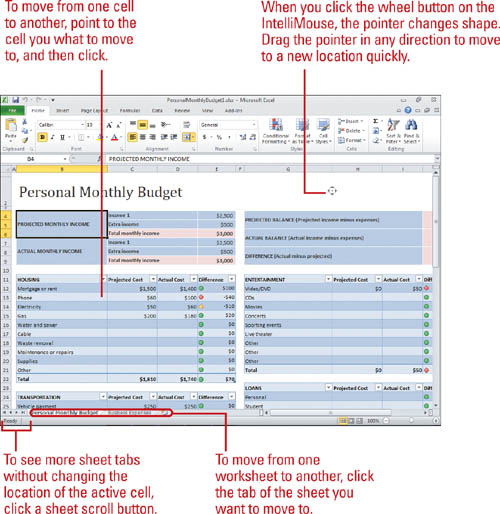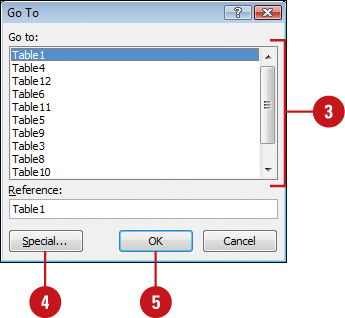You can move around a worksheet using your mouse or
the keyboard. You might find that using your mouse to move from cell to
cell is most convenient, while using various keyboard combinations is
easier for quickly covering large areas of a worksheet. Or, you might
find that entering numbers on the keypad and pressing Enter is a better
method. Certain keys on the keyboard—Home, End, and Delete to name a
few—are best used as shortcuts to navigate in the worksheet. However,
there is no right way; whichever method feels the most comfortable is
the one you should use.
Use the Mouse to Navigate
Using the mouse, you can navigate to:
- Another cell
- Another part of the worksheet
- Another worksheet

Did You Know?
Microsoft IntelliMouse users can roll from cell to cell with IntelliMouse.
If you have the new Microsoft IntelliMouse—with the wheel button
between the left and right buttons—you can click the wheel button and
move the mouse in any direction to move quickly around the worksheet.
You can quickly zoom in or out using IntelliMouse.
Instead of scrolling when you roll with the IntelliMouse, you can zoom
in or out. To turn on this feature, click the File tab, click Options,
click Advanced, select the Zoom On Roll With IntelliMouse check box, and
then click OK.
|
Excel takes advantage of
new technology to help you store more data and increase performance.
Excel now supports over 1 million rows and 16 thousand columns in each
worksheet, dual-processors and multithreaded chips, memory management up
to 2 GB, and up to 16 million colors.
|
Use the Keyboard to Navigate
Using the keyboard, you can navigate in a worksheet to:
- Another cell
- Another part of the worksheet
Refer to the table for keyboard shortcuts for navigating around a worksheet.
You can change or move cell selections after pressing Enter.
When you press Enter, the active cell moves down one cell. To change
the direction, click the File tab, click Options, click Advanced, click
the Direction list arrow, select a direction, and then click OK.
| Press This Key | To Move |
|---|
| Left arrow | One cell to the left | | Right arrow | One cell to the right | | Up arrow | One cell up | | Down arrow | One cell down | | Enter | One cell down | | Tab | One cell to the right | | Shift+Tab | One cell to the left | | Page Up | One screen up | | Page Down | One screen down | | End+arrow key | In the direction of the arrow key to the next cell containing data or to the last empty cell in current row or column | | Home | To column A in the current row | | Ctrl+Home | To cell A1 | | Ctrl+End | To the last cell in the worksheet containing data |
|
Go To a Specific Location
 Click the Home tab. Click the Home tab.
 Click the Find & Select button, and then click Go To. Click the Find & Select button, and then click Go To.
 Type the cell address to the cell location where you want to go. Type the cell address to the cell location where you want to go.
 To go to other locations (such as comments, blanks, last cell, objects, formulas, etc.), click Special, select an option, and then click OK. To go to other locations (such as comments, blanks, last cell, objects, formulas, etc.), click Special, select an option, and then click OK.
Timesaver
To open the Special dialog box directly, click the Find & Select button, and then click Go To Special.
 Click OK. Click OK.

|